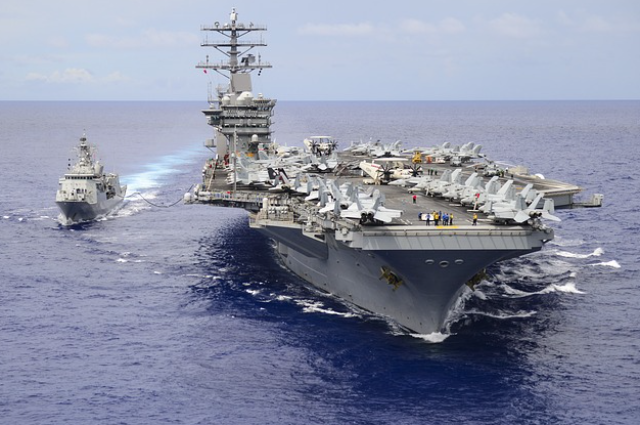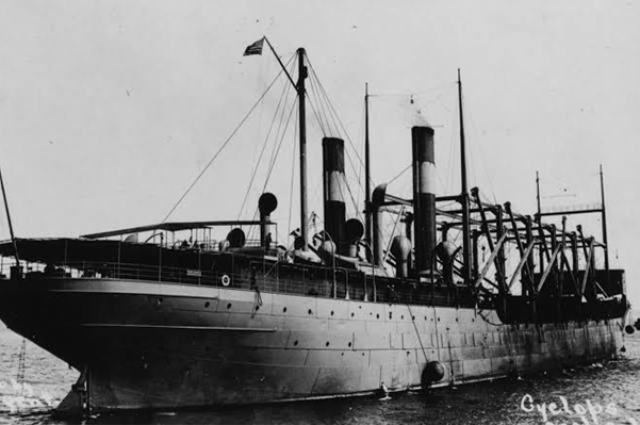
The Disappearance of the USS Cyclops is a stark reminder of how even the largest most advanced ships can vanish without a trace swallowed by the vast and unpredictable ocean.

The story of Dwaraka City reminds us of how the sea can preserve and protect history hiding the traces of ancient civilizations beneath its waves until their rediscovered centuries later. But not every ocean mystery leaves behind clues some vanish entirely leaving us with more questions than answers as we move from the depths of antiquity to the Modern Age. We encounter an Enigma one that has baffled sailors historians and investigators for over a century. This mystery doesn’t involve an ancient city or the slow encroachment of rising seas, instead, it revolves around a massive ship a wartime voyage, and a disappearance so complete that no Trace has ever been found.
The year was 1918 and the USS Cyclops, a colossal Naval vessel was on a routine journey through the Atlantic on board were over 300 men thousands of tons of cargo, and a sturdy ship built to withstand the rigors of war. But somewhere between Barbados and Baltimore, the Cyclops disappeared without a trace. There was no distress signal no wreckage, no survivors it was as if the ship had been swallowed whole by the ocean. What happened to the USS Cyclops? Was it a mechanical failure? A sudden storm or something far more sinister to this day no one knows let’s dive into the haunting story of the Cyclops a ship that sailed into history and never returned.
Purpose
In the early 20th century the US Navy was a force on the rise with ambitions of projecting power across the globe. It was clear that Naval supremacy would depend not only on warships but also on the critical logistics that kept them operational enter. The USS Cyclops, a behemoth of her time and a critical asset to the Navy’s growing fleet launched in 1910. The Cyclops was one of four Proteus class Colliers built specifically to transport vast quantities of coal the lifeblood of naval operations in the era of steam-powered ships at an imposing 542 ft long and 65 ft wide.
Features
The Cyclops was a floating powerhouse capable of carrying over 12,000 tons of coal at a time. Her immense size and cargo capacity made her an engineering marvel and an indispensable tool for the Navy. Its operations were across vast distances but the Cyclops wasn’t just about size, her design was ahead of its time and built for durability. Her steel hull and watertight compartments were meant to handle even the harshest seas. Inside her enormous holds were meticulously organized to maximize cargo efficiency. Her top speed was a modest 15 knots, she was designed for reliability and her sturdy construction ensured that she handled the rigors of long voyages by the time.
Vessel to Cargo
World War I broke out in 1914, and coal was no longer the Navy’s only priority. Oil was rapidly becoming the fuel of choice for warships rendering Coal less critical but this didn’t mean the Cyclops was obsolete instead her role shifted. She became a multi-purpose vessel carrying not just fuel but any cargo the Navy needed ammunition supplies. Even with troops in this new capacity, she became a workhorse of the fleet.
The Journey
A vessel that could be relied upon to deliver vital resources wherever they were needed. In January 1918, the Cyclops received a new mission she was ordered to transport 10,800 tons of Manganese ore from Brazil to the United States. Manganese was a key material for the war effort essential for strengthening steel used in weapons and Machinery. The journey would take her from Rio de Janeiro to Salvador Brazil and then North to Baltimore Maryland.
The Cyclops departed Rio de Janeiro arriving in Salvador in mid-February. After taking on her full cargo she began the long Voyage North, her route would take her through the Caribbean a stretch of ocean known for its calm waters and predictable weather. It was by all accounts a routine mission one the Cyclops had completed many times before. The ship made a scheduled stop in Barbados on March 3rd, 1918 to resupply and allowed her captain Lieutenant Commander George Worley to file a report by all accounts.
Everything seemed normal the Cyclops was in good condition and there were no signs of trouble. She departed Barbados on March 4th bound for Baltimore with an expected arrival date later that month. But somewhere between Barbados and Baltimore, the Cyclops vanished. She sent no distress signal, made no calls for help and left no trace of her passage.
The disappearance
The massive ship her 309 passengers, crew, and her cargo of Manganese ore all disappeared as if swallowed by the ocean itself. The Disappearance of the USS Cyclops was a shock to the US Navy and the nation at large. This wasn’t just any ship, it was a massive military vessel equipped with experienced sailors and built to endure the rigors of the sea. How could such a ship vanish without a trace? The mystery became an immediate focus of Naval investigations but the lack of evidence left everyone grasping. Its straws search efforts began as soon as the ship failed to arrive in Baltimore.
The cyclops’s expected route covering thousands of square miles of ocean ports along the East Coast, the Caribbean, and South America were alerted to keep an eye out for wreckage or survivors. Wireless stations still a relatively new technology listened for any possible signals from the ship but there was nothing. No lifeboats, no debris, no oil slicks. The Cyclops had seemingly disappeared without a trace. The lack of physical evidence only deepened the mystery.
Questions with no Answers
Normally even in catastrophic sinkings some form of debris, planks life preservers cargo eventually washes ashore but in the case of the Cyclops, the ocean remained eerily silent as if the ship had been swallowed whole by the Atlantic. Adding to the Strangeness was the fact that the Cyclops had not sent a distress signal while Wireless communication in 1918 was still rudimentary. The ship was equipped with a working radio and a trained operator. If there had been time to send a distress call why hadn’t they this raised? The unsettling possibility that whatever happened to the ship had occurred so suddenly that the crew had no time to react. Over a century has passed since the USS Cyclops vanished but the mystery remains as compelling as ever. With advancements in technology and renewed interest in Maritime history.
Modern researchers have revisited the case hoping to uncover new evidence or develop plausible theories that could finally explain the ship’s disappearance. One of the more recent technological developments that have reignited interest in the Cyclops is the use of deep-sea exploration tools including remotely operated vehicles and advanced Sonar mapping systems. These technologies have allowed researchers to explore parts of the ocean that were once unreachable. While no confirmed wreckage of the Cyclops has been found. These tools have uncovered dozens of previously unknown shipwrecks in the region demonstrating that even the largest vessels can remain hidden in the vast expanse of the ocean.
Theories
Some modern theories have focused on structural issues with the Cyclops historical records suggest that the Ship’s design may have made her vulnerable to instability when heavily loaded. The manganese ore she was carrying was both dense and prone to Shifting if improperly secured. Even a small shift in the cargo’s weight could have destabilized the ship causing her to capsize rapidly. This theory aligns with the absence of a distress signal, if the ship had capsized or broken apart suddenly the crew would have had no time to react.
Another line of Investigation focuses on Captain George Worley whose leadership has long been a subject of speculation war’s erratic behavior and questionable decisions during previous Voyages have led some to wonder whether he might have played a role in the Cyclops’s fate. Witnesses from earlier Voyages described him as abrasive and unpredictable and rumors persist that his German Heritage raised suspicions during a time of heightened wartime paranoia. However, there is no hard evidence to suggest that Worley deliberately sabotaged the ship or acted maliciously.
Recent studies of Wartime Record records have also reignited the theory of enemy action during World War I. Germans operated extensively in the Atlantic targeting Allied ships, while no confirmed reports links are found. It is possible that her disappearance was the result of an unrecorded attack German Naval. Records from the era are incomplete leaving room for speculation. However, the lack of debris or survivors remains a sticking point for this Theory. Typically even in a German attack, some trace of the ship would be expected to surface.
The Bermuda Triangle Theory, although it often dismissed by scientists, continues to captivate the public imagination. The Cyclops disappeared in a region known for its association with mysterious vanishings and some have speculated that the ship fell victim to a phenomenon unique to the area from methane hydrate eruptions to rogue waves and magnetic anomalies.
Various natural explanations have been proposed while most of these theories remain unproven. They add an extra layer of intrigue to the Cyclops’s story. One of the most compelling modern theories is the possibility that the Cyclops sank due to a combination of factors a minor structural failure exacerbated by her heavy load and potentially rough seas could have set off a chain reaction, leading to her rapid sinking. This theory acknowledges that the ship’s disappearance may not have been caused by a single catastrophic event but rather a perfect storm of circumstances.
Conclusion
The Cyclops’s disappearance has also inspired efforts to locate her wreckage organizations specializing in Maritime. Archaeology and underwater exploration have proposed targeted searches of the ship’s likely route using modern mapping technology. However, the vast size of the search area and the depth of the Atlantic Ocean present significant challenges. Despite these difficulties, researchers remain hopeful that one day the mystery of the Cyclops will be solved. Until then the USS Cyclops remains a haunting reminder of the ocean’s power to hide its secrets whether she lies intact on the seabed or was torn apart by the elements her story continues to inspire curiosity and speculation.
